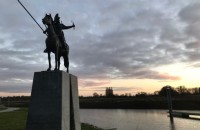November-December 1813: the Netherlands liberated from Napoleon – multiple perspectives
Mid-November 1813, the first troops of the Sixth Coalition reached the Dutch part of Napoleon’s empire. Within a few weeks, the current Dutch territory was for the most part stripped of Napoleon’s military hold. The way this (self-?) liberation is viewed to this day, is strongly influenced by late 19th-century national politically biased views.
Multiple perspectives
Within the international historiography of the fall of Napoleon and the demise of the French Empire, the Dutch campaign is no more than a footnote. Nevertheless, it is striking that the visions on the events in the Netherlands give n alternative picture as described differently in national historiographies. This came to the fore during the Dutch-Russian Friendship Year 2013.
Background
Museum Geelvinck was one of the participants in that Friendship Year, which coincided with the start of the celebration of the Bicentennial of today’s Kingdom of the Netherlands. In collaboration with the State Pushkin Museum and the Glinka Russian National Museum of Music (both in Moscow), we organized the exhibition ‘1813: The Netherlands liberated by the Russians!‘. The exhibition was opened by the Vice-Minister of Culture of the Autonomous Republic of Bashkortostan, Mrs Valentina Latipova, in the presence of, among others, the Chair of the City Council of Amsterdam-Centrum, Mr. Boudewijn Oranje, and the Mayor of the Municipality of Heerde, Mrs. Inez Pijnenburg.
From this meeting, and later meetings in Ufa, Heerde and Wijhe, a warm bond arose between Bashkortostan and the municipalities of Heerde and Olst-Wijhe. This has led to the initiative for the placement of two complementary works of art in Veessen and Wijhe, which would make a lasting memory of this shared history visible. The monument was designed and executed by the sculptor Alexander Taratynov. On 11 January 2018 the sculpture ‘North Amurs’, a gift of the Republic of Bashkortostan, was placed in Veessen, near the site where the Bashkir had constructed the ship bridge over the IJssel River in November 1813. On Saturday 27th November 2021, the bivouac monument encompassing the sculpture of Gen. Alexander von Benckendorff will be unveiled to mark the site of the bivouac of the Russian 1st Bashkir Regiment in Wijhe. The monuments commemorate the shared history with the Bashkir and their prominent role in the Dutch Campaign under command of the Russian General Alexander von Benckendorff. This mainly Russian campaign put an end to Napoleon’s military hold on the Low Countries and tipped the local magistracy, partly under pressure from the Dutch population, to the camp of the Sixth Coalition and the Orangists.
Narrative
For about a month from mid-November 1813, the Russian 1st Bashkir Regiment had as its base camp a bivouac in Wijhe. A ship bridge was built across the River IJssel near Veessen. The strikingly foreign cavalrymen were among the first to reach Amsterdam and The Hague, as can be seen in several images from the time. For their courageous actions at the Siege of Breda, which marked the definitive end of Napoleon’s military influence on the present-day Dutch territory, the regiment’s commander, Prince Fedor Fedorovich Gagarin, was awarded an important decoration by Tsar Alexander I. The bold actions during this campaign under the inspiring leadership of Alexander Benckendorff – including a true feat, that led the provisional city government of Amsterdam to pass to the side of the Orangist provisional government in The Hague – had a decisive influence on political developments, which laid the foundation of the current Dutch constitutional Orange-monarchy.
International scientific conference in Autumn 2022
Within the international historiography of the fall of Napoleon and the demise of the French Empire, the Dutch campaign is no more than a footnote. Nevertheless, it is striking that the visions on the events in the Netherlands give n alternative picture as described differently in national historiographies. This came to the fore during the Dutch-Russian Friendship Year 2013.
Since 2014, our museum been investigating this history together with the Historical Association Wijhe and with the support of historians from Bashkortostan. Gradually, more puzzle pieces surface. With this international scientific conference, we want to highlight the various different national perspectives on how to look at these events.
Initiating online-meeting
On 17 November 2021, in preparation for the actual international scientific conference, which is scheduled for Autumn 2022, an international – English-language – online meeting for the experts involved will be organised by Museum Geelvinck together with the Historical Association Wijhe in collaboration with the Ministry of Culture of the Autonomous Republic of Bashkortostan (Russian Federation).
More information preparations conference | Program Kick-off
Сайт Музея Гелвинк Королевство Нидерландов
P.S. Проект реализуется при поддержке Фонда президентских грантов.
#ПрезидентскиеГранты#ФондПрезидентскихГрантов#МеждународнаяконференцияРоссияНидерландывэпохунаполеоновскихвойн#GeelvinckMuziekMusea#Башкирскийгосударственныйуниверситет#АвтономнаянекоммерческаяорганизацияпоразвитиюобщественнокультурныхинициативЦентрмежкультурногопартнёрства




